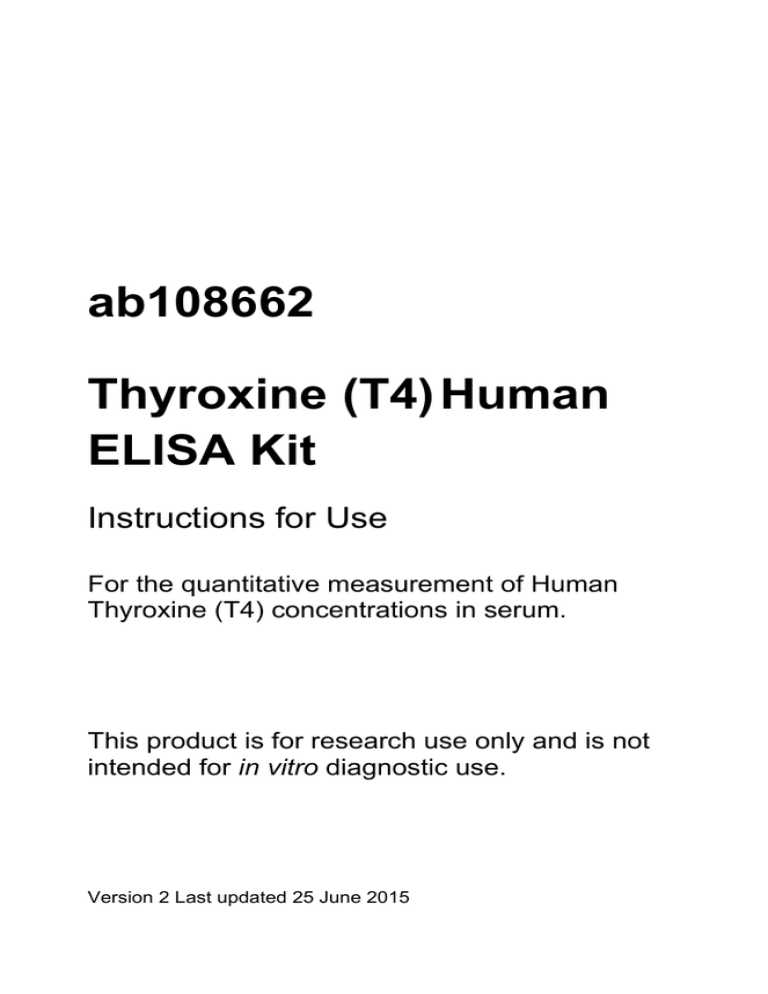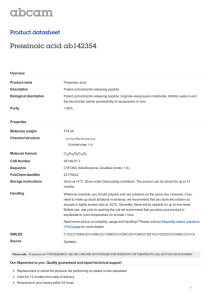
ab108662
Thyroxine (T4) Human
ELISA Kit
Instructions for Use
For the quantitative measurement of Human
Thyroxine (T4) concentrations in serum.
This product is for research use only and is not
intended for in vitro diagnostic use.
Version 2 Last updated 25 June 2015
1
Table of Contents
1.
Introduction
3
2.
Assay Summary
4
3.
Kit Contents
5
4.
Storage and Handling
5
5.
Additional Materials Required
6
6.
Preparation of Reagents
6
7.
Preparation and Collection of Specimen
7
8.
Assay Method
7
9.
Data Analysis
9
10. Limitations
13
11. Specificity
14
12
15
Troubleshooting
2
1. Introduction
ab108664, Thyroxine (T4) Human ELISA Kit is intended for the
quantitative determination of Free Thyroxine (T4) concentration in
Human serum.
Thyroxine (T4) or 3,5,3’,5’-tetraiodothyronine is the most commonly
measured thyroid hormone for the diagnosis of thyroid function.
Thyroxine (T4) has its primary infuence on protein synthesis and
oxygen consumption in virtually all tissues but it is also important for
growth, development, and sexual maturation. Thyroxine (T4) is
synthesized by the thyroid gland and is secreted into the
bloodstream. Here the Thyroxine (T4) becomes bound to serum
proteins for transport to the cells. The major transport protein is
Thyroxine Binding Globulin (TBG) which normally accounts for 80%
of the bound T4. Other thyroid hormone binding proteins are
Thyroxine Binding Prealbumin and Albumin. Most of the serum T4 is
bound to these transport proteins leaving only about 0.03% free to
exert its effect on cells. It is the free T4 (fT4) that represents the
metabolically active fraction; for this reason the measurement of fT4
concentration is considered to be an indicator of patient thyroid
status..
3
2. Assay Summary
ab108664 is based on the principle of solid phase competitive
enzyme immunoassay.
Patient serum samples, standards, and Thyroxine-Enzyme
Conjugate Working Reagent are added to wells coated with
monoclonal Thyroxine (T4) antibody. fT4 in the patient specimen and
the Thyroxine (T4) labeled conjugate compete for available binding
sites on the antibody.
After 60 minutes incubation at room temperature, the wells are
washed with water to remove unbound Thyroxine (T4) conjugate.
A solution of H O /TMB is then added and incubated for 20 minutes,
2
2
resulting in the development of blue color.
The color development is stopped with the addition of 3N HCl, and
the absorbance is measured spectrophotometrically at 450 nm. The
intensity of the color formed is proportional to the amount of enzyme
present and is inversely related to the amount of unlabeled fT4 in the
sample. By reference to a series of fT4 standards assayed in the
same way, the concentration of fT4 in the unknown sample is
quantified.
4
3. Kit Contents
Antibody-Coated Wells (1 plate, 96 wells); microtiter wells
coated with Thyroxine (T4) Antibody.
Thyroxine (T4)-Enzyme Conjugate Reagent, ready to use,
10.5 ml.
Free Thyroxine (T4) Reference Standards, 0, 0.3, 1.05, 2.15,
3.6, and 8.05 ng/dl, 1 ml each
Color Reagent A, 13 ml
Color Reagent B, 13 ml.
Stop Solution (10 ml/bottle) contains diluted hydrochloric acid
(3N HCl).
4. Storage and Handling
Store the unopened kit at 2-8°C upon receipt and when it is not in
use, until the expiration shown on the kit label. Refer to the package
label for the expiration date. Keep microtiter plate in a sealed bag
with desiccant to minimize exposure to damp air. Opened test kits
will remain stable until the expiration date shown, provided it is
stored as described above.
5
5. Additional Materials Required
Distilled or deionized water
Precision pipettes: 5 μl, 10 μl, 50 μl, 100 μl and 1.0 ml
Disposable pipette tips
Microtiter well reader capable of reading absorbance at 450 nm.
Vortex mixer, or equivalent
Control Sera for quality control.
Timer.
Absorbent paper
Test tubes for dilution of enzyme conjugate and for mixing Color
Reagent A with Color Reagent B.
6. Preparation of Reagents
Before proceeding with the assay, bring all reagents, serum
references and controls to room temperature (18-25°C).
Working Substrate Solution – Prepare immediately before use
To prepare H O /TMB solution, make a 1:1 mixing of Color Reagent
2
2
A with Color Reagent B up to 1 hour before use. Mix gently to ensure
complete mixing. The prepared H O /TMB reagent should be made
2
2
at least 15 minutes before use and is stable at room temperature in
the dark for up to 3 hours. Discard excess after use.
6
7. Preparation and Collection of Specimen
1. Serum should be prepared from a whole blood specimen
obtained by acceptable medical techniques.
2. This kit is for use with serum samples without additives only.
3. Serum samples may be refrigerated at 2-8°C for a maximum
period of 48 hours. If the samples cannot be assayed within 48
hours, they may be stored at temperatures of -20°C for up to 30
days.
8. Assay Method
Assay Procedure:
Before proceeding with the assay, bring all reagents, serum
references and controls to room temperature (18-25°C).
1. Format the microplates’ wells for each serum reference, control,
and patient specimen to be assayed in duplicate.
2. Pipette 50 μl of the appropriate serum reference, control and
specimen into the assigned well.
3. Add 100 μl of Free Thyroxine (T4) Enzyme Conjugate Reagent
to all wells.
4. Swirl the microplate gently for 20-30 seconds to mix.
5. Incubate 60 minutes at room temperature.
7
6. Remove the incubation mixture by emptying the plate content
into a waste container. Rinse and empty the microtiter plate 5
times with distilled water. Strike the microtiter plate sharply onto
absorbent paper or paper towels to remove all residual water
droplets.
7. Add 200 μl of Working Substrate Solution to all wells (see
Reagent Preparation Section). Always add reagents in the
same order to minimize reaction time differences between
wells. Gently mix for 10 seconds.
8. Incubate at room temperature in the dark for 20 minutes.
9. Stop the reaction by adding 50 μl of 3N HCl (Stop Solution) to
each well.
10. Gently mix for 30 seconds. It is important to make sure that all
the blue color changes to yellow color completely.
11. Read absorbance at 450 nm with a microtiter well reader within
30 minutes.
8
9. Data Analysis
1. Calculate the mean absorbance value (OD450) for each set of
reference standards, controls and patient samples.
2. Construct a standard curve by plotting the mean absorbance
obtained for each reference standard against its concentration in
ng/dl on graph paper, with absorbance values on the vertical or
Y axis, and concentrations on the horizontal or X axis.
3. Use the mean absorbance values for each specimen to
determine the corresponding concentration of fT4 in ng/dl from
the standard curve.
A.
Typical Data
Results of a typical standard run with optical density readings at 450
nm shown in the Y axis against fT4 concentrations shown in the X
axis.
NOTE: This standard curve is for the purpose of illustration only,
and should not be used to calculate unknowns. Each laboratory must
provide its own data and standard curve in each experiment.
9
fT4 (ng/dl)
Absorbance (450 nm)
0
2.496
0.3
2.292
0.95
1.903
2.1
1.295
3.6
0.819
7.0
0.410
10
B.
Sensitivity
The fT4 EIA procedure has a sensitivity of 0.05 ng/dl. The sensitivity
was ascertained by determining the variability of the 0 ng/dl serum
calibrator and using the 2σ (95% certainty) statistic to calculate the
minimum dose.
C.
Reproducibility
Intra-Assay: Within-run precision was determined by analyses on
three different levels of pool control sera. The number, mean values,
standard deviation and coefficient of variation for each of these
control sera are shown in the following table:
Serum Sample
Low
Normal
High
# Reps.
16
16
16
X (ng/dl)
0.3
1.4
3.6
S.D.
0.03
0.06
0.22
C.V. (%)
9.8
4.5
6.2
11
Inter-Assay: Between-run precision was determined by analyses on
three different levels of pool control sera. The number, mean values,
standard deviation and coefficient of variation for each of these
control sera are shown in the following table:
Serum Sample
Low
Normal
High
# Reps.
10
10
10
X (ng/dl)
0.34
1.35
3.69
S.D.
0.04
0.07
0.25
C.V. (%)
11.5
3.7
4.2
E. Effects of Exogenous Added Drugs
fT4 concentrations were determined in the presence of each of
several drugs added to serum at approximately twice the normal
therapeutic serum concentration level. The % change in apparent
fT4 found in the presence of these drugs was measured, and is
shown in the table below.
12
Substance
Final
% Change in
Concentration
FT4
Exogenous
Concentration
Drug
10.
Sodium salicylate
40 mg/dl
+ 1.8
Diphenylhydantoin
30 μg/dl
+ 28.0
Propylthiouracil
4 mg/dl
+ 18.7
Phenylbutazone
30 mg/dl
+ 0.8
Limitations
Reliable and reproducible results will be obtained when the
assay procedure is carried out with a complete understanding of
the package insert instructions and with adherence to good
laboratory practice.
The wash procedure is critical. Insufficient washing will result in
poor precision and falsely elevated absorbance readings.
Serum samples demonstrating gross lipemia, gross hemolysis,
or turbidity should not be used with this test.
13
11. Specificity
Results are expressed as the ratio of the fT4 concentration to the
concentration of the cross-reactant that will displace 50% of the
bound Thyroxine (T4) enzyme conjugate x 100%.
Cross-Reactant
% Cross-Reactivity
l-Thyroxine (T4)
100
d-Thyroxine
100
l-Triiodothyronine (T3)
4.5
d-Triiodothyronine
Diiodotyronine
5.4
<0.06
Diiodotyrosine
<0.05
Iodotyrosine
<0.05
Phenytoin
<0.05
Sodium Salicylate
<0.05
14
12. Troubleshooting
Problem
Cause
Solution
Poor standard
curve
Improper standard dilution
Confirm dilutions made
correctly
Standard improperly
reconstituted (if
applicable)
Briefly spin vial before
opening; thoroughly
resuspend powder (if
applicable)
Standard degraded
Store sample as
recommended
Curve doesn't fit scale
Try plotting using different
scale
Incubation time too short
Try overnight incubation at
4 °C
Target present below
detection limits of assay
Decrease dilution factor;
concentrate samples
Precipitate can form in
wells upon substrate
addition when
concentration of target is
too high
Increase dilution factor of
sample
Using incompatible
sample type (e.g. serum
vs. cell extract)
Detection may be reduced
or absent in untested
sample types
Sample prepared
incorrectly
Ensure proper sample
preparation/dilution
Bubbles in wells
Ensure no bubbles
present prior to reading
plate
Low signal
Large CV
15
High
background
Low sensitivity
All wells not washed
equally/thoroughly
Check that all ports of
plate washer are
unobstructed/wash wells
as recommended
Incomplete reagent mixing
Ensure all
reagents/master mixes
are mixed thoroughly
Inconsistent pipetting
Use calibrated pipettes &
ensure accurate pipetting
Inconsistent sample
preparation or storage
Ensure consistent sample
preparation and optimal
sample storage conditions
(eg. minimize
freeze/thaws cycles)
Wells are insufficiently
washed
Wash wells as per
protocol recommendations
Contaminated wash buffer
Make fresh wash buffer
Waiting too long to read
plate after adding STOP
solution
Read plate immediately
after adding STOP
solution
Improper storage of
ELISA kit
Store all reagents as
recommended. Please
note all reagents may not
have identical storage
requirements.
Using incompatible
sample type (e.g. Serum
vs. cell extract)
Detection may be reduced
or absent in untested
sample types
For further technical questions please do not hesitate to
contact us by email (technical@abcam.com) or phone (select
“contact us” on www.abcam.com for the phone number for
your region).
16
17
18
UK, EU and ROW
Email: technical@abcam.com | Tel: +44-(0)1223-696000
Austria
Email: wissenschaftlicherdienst@abcam.com | Tel: 019-288-259
France
Email: supportscientifique@abcam.com | Tel: 01-46-94-62-96
Germany
Email: wissenschaftlicherdienst@abcam.com | Tel: 030-896-779-154
Spain
Email: soportecientifico@abcam.com | Tel: 911-146-554
Switzerland
Email: technical@abcam.com
Tel (Deutsch): 0435-016-424 | Tel (Français): 0615-000-530
US and Latin America
Email: us.technical@abcam.com | Tel: 888-77-ABCAM (22226)
Canada
Email: ca.technical@abcam.com | Tel: 877-749-8807
China and Asia Pacific
Email: hk.technical@abcam.com | Tel: 108008523689 (中國聯通)
Japan
Email: technical@abcam.co.jp | Tel: +81-(0)3-6231-0940
www.abcam.com | www.abcam.cn | www.abcam.co.jp
19
Copyright © 2015 Abcam, All Rights Reserved. The Abcam logo is a registered trademark.
All information / detail is correct at time of going to print.




